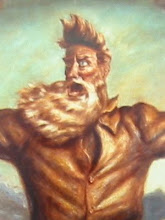The above photo illustrates what we call "Italian Style Hose Testing". It resembles a plate full of spaghetti
This image illustrates why you never stand over hose while it is being tested. This section of 2 1/2" hose failed within 5 feet of the pump panel. As the engineer was not straddling the hose, he escaped with only a bath. The fact that the discharge valve was opened just enough to introduce pressure to the hose, prevented damage to the rig.
Not straddling the hose and how to cross charged fire hose safely were among the first things I learned as a firefighter. For good reason it would seem.
Thanks for reading,
Schmoe




I'll bet the failure was something to see! How much pressure is on the hose during testing, and how much is the hose supposed to be able to withstand? And, while I'm at it, how do you cross a charged fire hose safely? I never would have thought about it until I read your post.
ReplyDeleteNice post, by the way.
(Hand from the back of the class): Say, Captain Schmoe, sorry, I fell asleep. Alright, I'll do pushups &c. after class. Anyhow, why don't you cross the lines, and what is "cross charged?" I know it was on the handout... I'm sorry. Would you believe the dog ate it? I didn't think so. So what makes a failing hose so dangerous? I'm guessing it turns a malevolent version of those whip-around-and-get-everything-wet toys we put on the end of the garden hose when we were kids.
ReplyDeleteMad Jack - The only person who saw it was the engineer, as it was on the side of the engine, away from the rest of us. We all heard it though and we did get to see the wet engineer.
ReplyDeleteFire hose is tested at the manufacturer at 600 psi for five minutes prior to it being shipped. We test it annually at 250 psi for five minutes. Depending on where the failure occurs, we may recouple the hose, retest and continue using it. We will not use a hose shorter than 40' long. (manufactured length is 50')
The safest way to cross a charged hose line is to do it in a fashion that causes your legs to be crossed as you cross the hose. That way, your little hose is protected from the big hose should it fail.
Wayne - In a perfect world, the hose lays should be 300' long, straight and uncrossing because some of us are not as mindful as others and tend to observe the hose test from a convenient and stationary position (meaning they are lazy) and might miss a small problem such as a small leak, a bulge or sweating. When we test "Italian Style" we make sure that each crew member takes a specific area and continually walks that area looking for problems.
Understand that the test is about pressure, not volume. While filling the hose, the discharge valve is opened to allow for rapid filling. Once the desired pressure is attained, the discharge valve is then closed so that it is barely open - just enough to maintain pressure. That way if the hose fails not much water will come out, hopefully limiting damage. If this step is omitted, it's water wiggle city.
Thanks for the comments.
Hose is tested at the manufacturer at 600 psi for five minutes.